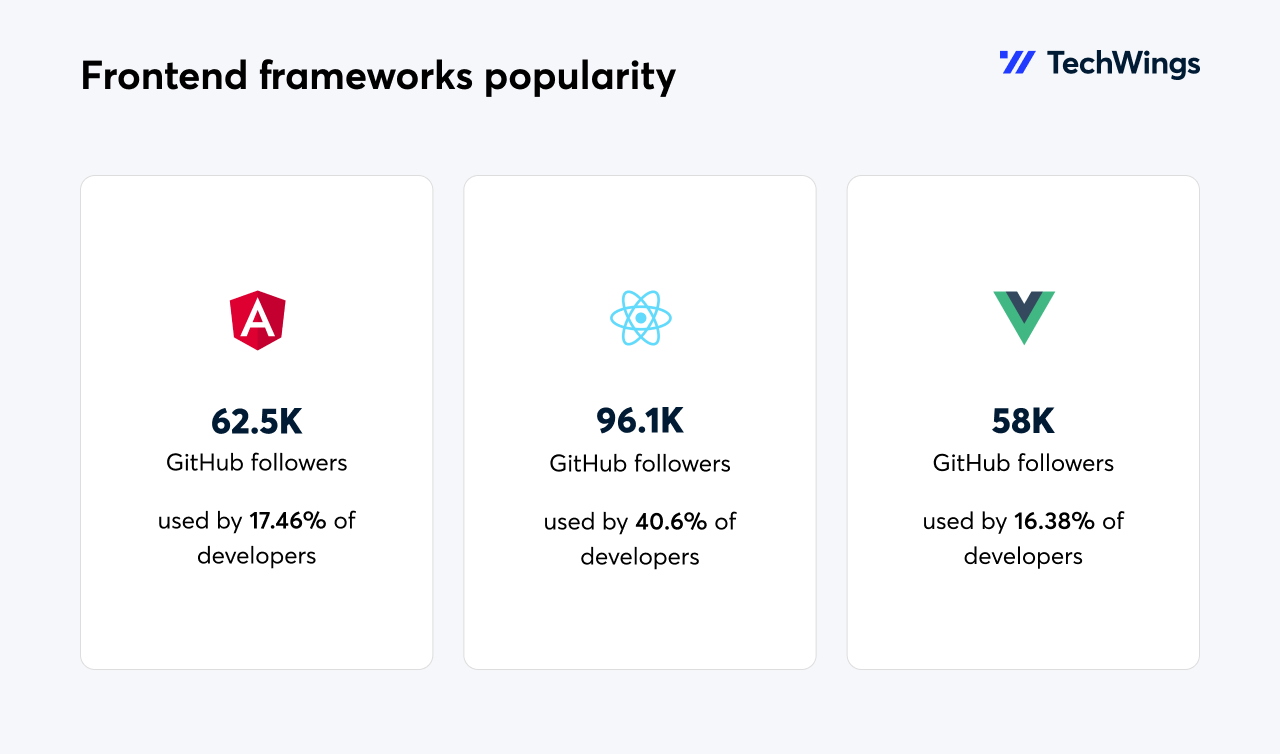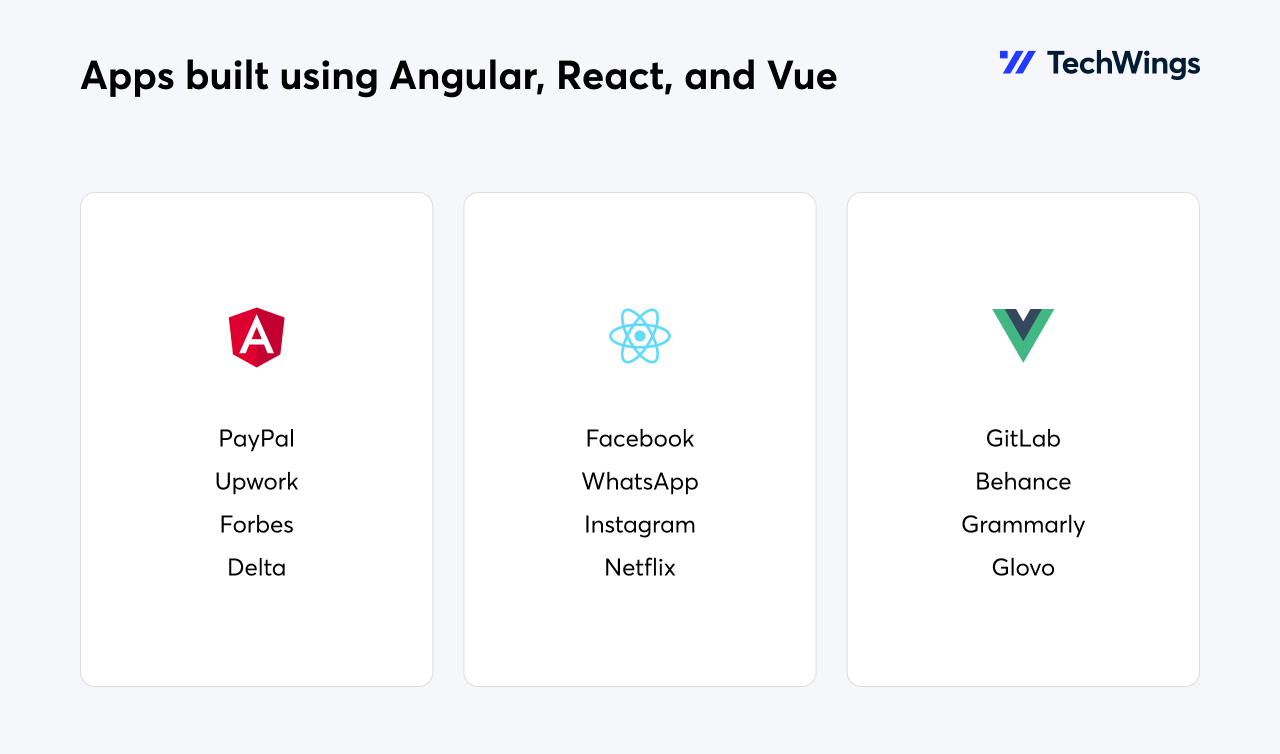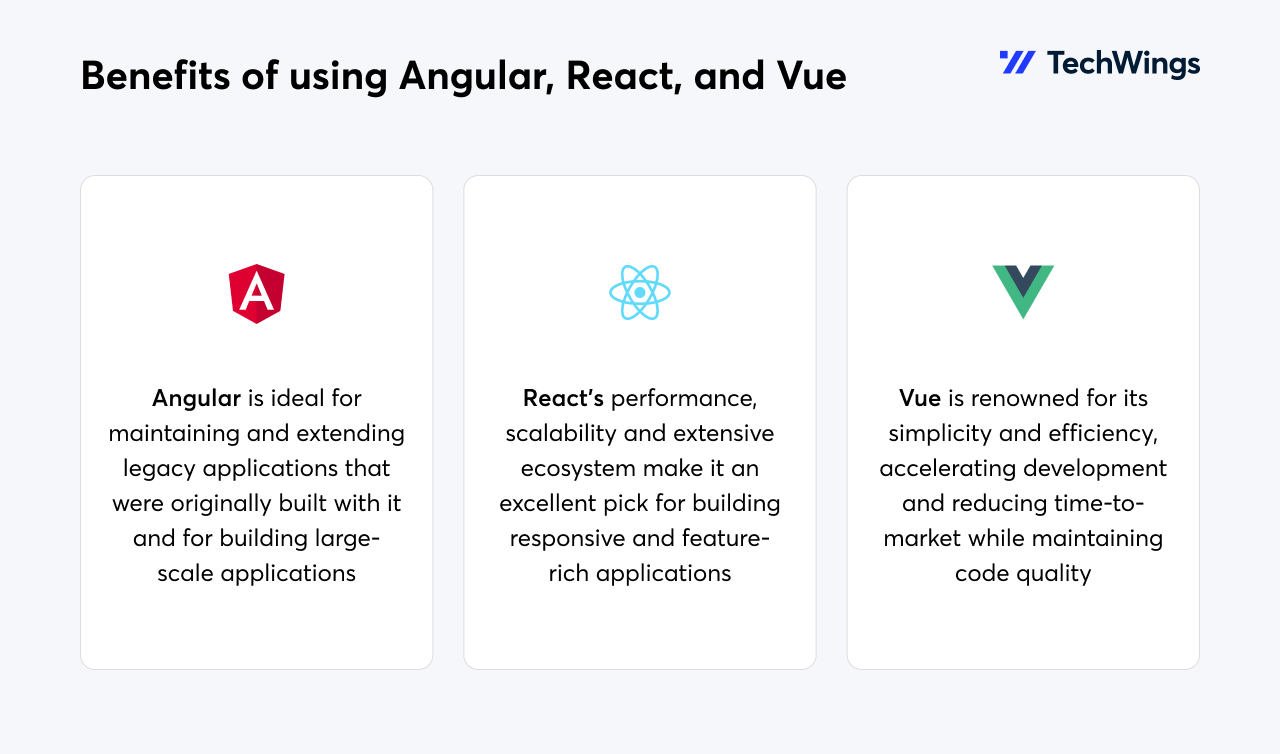Angular vs React vs Vue: choosing the best frontend framework
While backend systems are responsible for data storage and maintaining your app’s core functionality, the frontend is the first touchpoint with your users. And first impressions matter: a well-designed frontend is vital for creating rewarding user experiences and retaining your audience.
Frontend design determines how responsive, accessible, mobile-friendly, and easy to use your web app is, as well as whether it can meet your unique project requirements and business goals.
The good news is that all of these elements can be achieved quickly and efficiently by using a frontend framework that best addresses your needs. In this article, we’ll take a closer look at the most popular JavaScript frameworks: Angular, React, and Vue (with 62.5K, 96.1K, and 58K followers on GitHub, respectively) and compare them from a business perspective to help you make a winning choice.
So, in which ways is Angular better than React? What are the differences between React and Vue? What are the advantages of React over Angular? Which is a better choice for a feature-rich, responsive app: Vue, React, or Angular? Read on to find the answers to all these questions and more.
A detailed comparison: Angular.js vs React.js vs Vue.js
Let’s explore key differences between Angular.js, React.js, and Vue.js, looking at their key features, performance, scalability, common use cases, and business value.
Quick overview
React
React.js is an open-source frontend JavaScript library for building user interfaces out of individual components released by Facebook (Meta Platforms today) in May 2013.
According to a 2023 survey, React is the most popular choice for frontend development: 40.6% of developers have been using this framework. It is renowned for introducing the concept of a virtual DOM and popularizing the use of component-based architecture.
Additionally, React extends beyond web development. React Native enables the development of mobile applications for iOS and Android using the same component model, making it a powerful tool for cross-platform development.
One of the major advantages of React.js over Angular.js, Angular 2+, and Vue.js is extensive community support.
Angular
Released in October 2010 by Google, Angular.js, or Angular 1.x, is an open-source JavaScript-based web framework for developing single-page applications. However, Angular.js has been discontinued and is being gradually replaced by its updated version, Angular or Angular 2+.
The most current statistic says that Angular is used by 17.46% of developers, ranking third among frontend frameworks. Meanwhile, its predecessor, Angular.js, is still popular with 7.21% of respondents.
Angular 2+ is often called a “batteries-included” framework since it provides a comprehensive solution for building web apps. It includes features like routing, forms handling, HTTP client, and state management out of the box. The framework also offers two-way data binding, meaning that changes in the UI are reflected in the underlying data model automatically and vice versa.
Vue
Vue.js is an open-source frontend JavaScript library you can use for creating user interfaces and single-page applications. It was released by Evan You in February 2014. As of 2023, 16.38% of developers use Vue.
One of the primary advantages of Vue.js is that it can be incrementally adopted into existing projects — developers can use as much or as little of Vue.js as they need. In addition, Vue features a reactivity system enabling automatic UI updates as data changes, which translates to highly responsive user interfaces.
Key features
Angular
Angular.js enables automatic synchronization of data between the view and the model. The framework boasts a robust dependency injection system for managing components and services. Angular.js introduced custom HTML attributes (directives) for extending the functionality of HTML elements.
Similarly to Angular.js, Angular 2+ provides a powerful dependency injection system. However, Angular 2+ is built around a component-based architecture, making it highly modular and reusable. It uses TypeScript for strong typing, which can improve code quality and maintainability. The framework incorporates RxJS (Reactive Extensions for JavaScript) for handling asynchronous operations and observables.
React
One of the most distinctive features of React is its virtual DOM that allows for more efficient updates and better performance. The framework also uses JSX (a JavaScript extension enabling the creation of DOM trees with the help of XML-like syntax) to define components, making it easy to embed UI components within JavaScript. In addition, React enforces a unidirectional data flow for predictable updates.
Vue
As mentioned, Vue.js is incrementally adoptable, allowing developers to integrate it into existing projects. The framework promotes the organization of components in single files, simplifying development and maintainability. Vue also provides a reactivity system for efficient UI updates.
Performance
React
React’s virtual DOM and one-way data flow contribute to excellent performance, making it a go-to option for complex applications.
Angular
Angular.js can be slower than Angular 2+, Vue, and React due to its digest cycle and two-way data binding, which may lead to performance bottlenecks with large datasets.
On the other hand, Angular 2+ employs AOT compilation and reactive programming with RxJS, resulting in more efficient rendering and better performance for complex applications.
Vue
Vue.js offers high performance due to its reactive system and efficient rendering. As a result, it is suitable for a wide range of applications.
Scalability
React
React’s virtual DOM and efficient rendering make it suitable for building scalable applications with high performance. The virtual DOM optimizes updates, reducing the risk of performance degradation as the app grows. The framework’s component-based approach enables easy reuse of UI components, feeding into scalability.
Angular
Angular.js is associated with scalability challenges, especially in large and complex applications. Its two-way data binding and digest cycle can lead to slowed performance as the application scales. To top it off, Angular.js lacks the component-based architecture found in newer frameworks, making it less modular and less suitable for building highly scalable applications with complex data flows.
Conversely, Angular 2+ is a good choice for building scalable applications due to its component-based architecture. In addition, the AOT compilation and reactive programming with RxJS facilitate app performance, even as it grows in size and complexity.
Vue
Vue.js features a reactivity system that efficiently updates the UI when data changes, resulting in scalable and responsive user interfaces, even in applications with complex data flows. Because Vue is incrementally adoptable, it is a flexible option for scaling applications up.
Use cases
React
React excels at building high-performance web applications and interactive user interfaces. Moreover, React Native extends React’s component model to mobile app development for iOS and Android, making it a suitable choice for cross-platform development.
Top examples: Facebook, Instagram, WhatsApp, Netflix, Skype, Dropbox
Angular
Angular.js is used for maintaining and extending legacy applications built with it. This framework is also still a popular choice for small to medium-sized projects.
Top examples: Google Cloud Platform (GCP) Console, Forbes, Weather.com
Angular 2+ is well suited for building large-scale enterprise applications with complex data flows and component hierarchies. In addition, it provides infrastructure for building progressive web applications (PWAs) with features like service workers and lazy loading.
Top examples: Microsoft Office Online, PayPal, Upwork
Vue
Vue’s simplicity and flexibility mean it’s a great option for quickly prototyping new ideas.
Vue is excellent for projects of various sizes, offering a balanced combination of features and ease of use.
Top examples: Teleo, Grammarly, Glovo, WizzAir, GitLab, Behance
Business value
React
React’s performance and extensive ecosystem make it an excellent pick for building responsive and feature-rich applications. Let’s look at what React offers from a business perspective:
High performance: Due to its virtual DOM and efficient rendering, React is well suited for building high-performance applications with a smooth user experience.
Flexibility: The framework is highly flexible and can be used in various contexts, including web and mobile development with React Native, allowing for code reuse.
Vast ecosystem: React has a large ecosystem of third-party libraries and tools, such as Redux and React Router, which can enhance development efficiency.
Developer productivity: React’s component-based architecture and declarative syntax can improve developer productivity by enabling easier code reuse and collaboration.
Angular
Again, it’s vital to distinguish between Angular.js and Angular 2+, so let’s look at the business value they offer separately. Here are the key business advantages of using Angular.js in web app development:
Mature ecosystem: As the first version of Angular, it has a well-established ecosystem with a wide range of third-party libraries and resources available.
Legacy application support: Angular.js is useful for maintaining and extending legacy applications that were originally built with it.
On the other hand, as an improved version of Angular.js, Angular 2+ offers more benefits:
TypeScript integration: Angular uses TypeScript, providing strong typing and improved code quality, which enhances maintainability and reduces bugs.
Component-based architecture: Angular employs component-based architecture, making it highly modular, reusable, and ideal for building large-scale applications.
Performance: Ahead-of-Time (AOT) compilation and reactive programming with RxJS contribute to excellent performance, especially for complex applications.
Vue
Vue is renowned for its simplicity and efficiency, accelerating development and reducing time-to-market while maintaining code quality. This framework also comes with a few indisputable business benefits:
Incremental adoption: Vue.js is incrementally adoptable, allowing businesses to introduce it into existing projects without a complete rewrite, reducing migration risks.
Versatility: The library can be used for various types of projects, from small prototypes to large-scale applications.
Excellent performance: Vue’s reactivity system and efficient rendering contribute to high performance, leading to responsive user interfaces.
Angular vs React vs Vue: comparison table
Angular 1.x | Angular 2+ | React | Vue | |
|---|---|---|---|---|
Popularity (GitHub Stars, September 2023) | 90K | 90K | 213K | 205K |
Community and ecosystem | Established but smaller community | Large and active community | Large and active community | Growing and active community |
Development speed | Average | Fast | Fast | Fast |
Performance | Limited, may suffer from performance bottlenecks | Excellent performance due to AOT compilation and RxJS | Excellent performance due to virtual DOM | Excellent performance due to reactivity |
UI component | Third-party libraries like Angular Material | Third-party libraries like Angular Material | Third-party libraries like Material-UI, Ant Design | Third-party libraries like Vuetify, Element UI |
Internationalization (i18n) and localization | Limited support | Supported with ngx-translate | Supported with react-intl | Supported with vue-i18n |
Community support and maintenance | Community-driven, limited official support | Strong community support, maintained by Google | Strong community support, maintained by Meta Platforms | Strong community support |
Scalability | Suitable for small to medium apps | Suitable for large-scale apps | Suitable for large-scale apps | Suitable for small to medium apps |
Deployment options | Traditional web hosting, limited PWA support | Versatile hosting options, PWA support | Versatile hosting options, PWA support | Traditional web hosting, PWA support |
Package size | Typically smaller bundles | Varies based on project configuration | Varies based on project configuration | Typically smaller bundles |
Top apps | Google Cloud Platform (GCP) Console, Forbes, IBM Cloud Pak for Data | Microsoft Office Online, PayPal, Upwork | Facebook, Instagram, WhatsApp, Netflix, Skype, Dropbox | Teleo, Grammarly, Glovo, WizzAir, GitLab |
Angular vs React vs Vue: let TechWings help you choose the best framework
Choosing the best frontend framework for your project might be challenging, as Angular, React, and Vue each have unique benefits that cater to various needs.
For instance, if we compare Vue vs React performance, both frameworks excel in different ways, with Vue’s fine-grained reactivity system contributing to responsive user interfaces, while React’s virtual DOM and fiber architecture optimize rendering for complex applications.
On the other hand, Angular 2+ offers advantages over other frameworks through component-based architecture, AOT compilation, and strong typing with TypeScript, providing enhanced modularity, speed, and code quality for large-scale applications.
At TechWings, we have extensive experience building high-performance web applications using Angular x.1, Angular 2+, React, and Vue. If you need assistance in choosing the best frontend framework for your app, reach out to us. We’ll thoroughly analyze your project requirements to implement the best solution.



